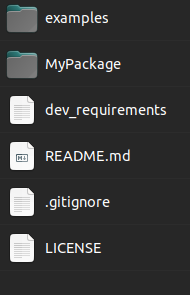Write some examples
If you’re bothering to release your code publically, you are probably hoping someone will use it. In that case, it is integral to have some simple of examples of using your code. Create a new folder inside DemoPythonProject called examples. At this point your repo (if you are doing this in order) should look like the image below.

Inside the examples folder create a file called demonstrate_sine_wave_plotter.py and copy the below code into it:
from pathlib import Path
import sys
'''
For testing/ example purposes it's safest to manually update the path variable to ensure our
package will always be found. This isn't necessary once we actually install the package
because installation in python essentially means "copying the package to a place where it can be found"
'''
this_file_loc = Path(__file__)
sys.path.insert(0, str(this_file_loc.parent.parent))
#Now we can guarantee that the package will be found we can import it:
import MyPackage
'''
the help and version for the package come from the __init__.py file:
'''
print(f'packge version = {MyPackage.__version__}. \nPackage info: {help(MyPackage)}')
MyPackage.sine_wave_utilities.sine_wave_plotter()
# since we are only using one function from this package a better way to import would be
from MyPackage.sine_wave_utilities import sine_wave_plotter
# or
from MyPackge import PlotSineWave as PSW
Now, for complex codes just a python file with no explanation of what’s happening or why is only moderately useful. There are a number of ways you can write examples:
This is one of the very things things that jupyter notebook is excellent for.
Alternatively, you can have your examples in pure python and explain what’s actually happening in your documentation
For more complex code, your examples may involve some test data that you ask the user to download.
When creating examples and documentation, ask yourself ‘what are some typical problems people have that I think this code can solve’ and provide examples of how someone can use the code to solve such problems